

HYSTERESIS. HYSTERESIS is a FREE glitch delay plugin geared toward creating robotic artifacts and abstract musical malfunctions.
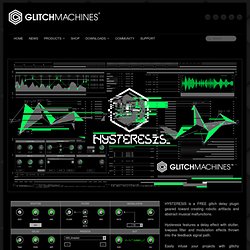
Hysteresis features a delay effect with stutter, lowpass filter and modulation effects thrown into the feedback signal path. Easily infuse your projects with glitchy articulations and abstract textures. Process anything from drums and percussion to synth lines and sound effects. On top of being able to create incredibly wild signal mutations, it can also be used to generate classic delay effects. Feedback-based delay effect with tempo syncReversible stutter effect in the feedback pathLowpass filter in the feedback pathModulation with rate division/multiplicationPresets by Ivo Ivanov, Thomas Hennebert, Daed & ApparitionCross-platform compatibility (PC/Mac – VST/AU 32bit & 64bit) Music and Computers. Www.analoguehaven.com/arturia/minibrute/manual.pdf. FM8 Tutorials. Absynth Tutorials. Massive Tutorials. Synth Secrets: SOS.
Roland Synth Chronicle. Roland Synth Chronicle: 1973 - 2013. OV Valle [Roland US] Products history, keyboards, Synth, Synthesizer 39 Comments Download a PDF version of the Roland Synthesizer Chronicle, 1973 through 2010.
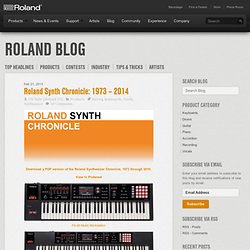
View in Pinterest 2014: FA-06 & FA-08 The series completely reimagines the music workstation, streamlining it for effortless real-time power, ultra-fast workflow, and maximum versatility. Ready to support any type of music you play, the FA-06 is packed with a massive sound collection inherited from the flagship INTEGRA-7, a ton of studio-quality effects, expressive real-time controls, and Axial ready. *The FA-08 features 88-note Ivory Feel-G Keyboard. 2013: V-Combo VR-09 This synth is travel-ready, affordable, and outfitted with top-level Roland sounds, the V-Combo VR-09 is the ideal all-in-one solution for performing keyboard players. 2012: INTEGRA-7 The powerhouse rack comprises a “greatest hits” collection of sounds from Roland’s flagship keyboards and V-Drums modules, plus a coveted lineup from the legacy SRX library.
Synthesis Basics. Table of Contents Introduction This article is a (relatively) brief introduction to the principles of music synthesis.
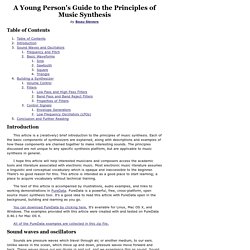
Each of the basic components of synthesizers are explained, along with descriptions and examples of how these components are chained together to make interesting sounds. The principles discussed are not unique to any specific synthesis platform, but are applicable to music synthesis in general. I hope this article will help interested musicians and composers access the academic tools and literature associated with electronic music. The text of this article is accompanied by illustrations, audio examples, and links to working demonstrations in PureData.
You can download PureData by clicking here. All of the PureData examples are collected in this zip file. Sound waves and oscillators Sounds are pressure waves which travel through air, or another medium, to our ears. The first such device we'll consider is called an oscillator. Frequency and pitch Basic waveforms Sine Sawtooth. Waveform Ref. Analog Synth School. 1971 Robert (Bob) Moog created the legendary Minimoog.
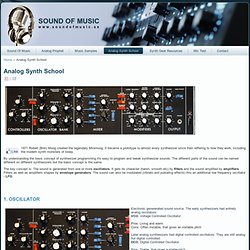
It became a prototype to almost every synthesizer since then reffering to how they work, including the modern synth monsters of today. By understanding the basic concept of synthesizer programming it's easy to program and tweak synthesizer sounds. The different parts of the sound can be named different on different synthesizers but the basic concept is the same. The key concept is: The sound is generated from one or more oscillators. It gets its character (harsh, smooth etc) by filters and the sound amplified by amplifiers.
Electronic genererated sound source. Pros: Living and warm Cons: Often instable, that gives an instable pitch Later analog synthesizers had digital controlled oscillators: They are still analog but digital controlled.DCO, Digital Controlled Oscillator Pros: Stable, that given a stable pitchCons: Not as warm as an analog The note can be normal, or can glide between the notes, called glide or portamento 1. 2. The 40 greatest synth sounds. When our friends at Future Music magazine compiled a list of the 40 greatest synth sounds of all time in 2008, it was nothing if not controversial.
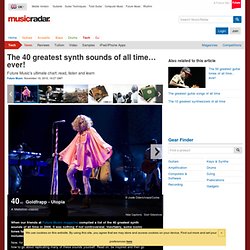
Inevitably, some iconic tones failed to make the cut, but few would deny that the majority of the sounds that were included have attained classic status. Now, for the first time, we can present the full list complete with analysis, audio and advice on how to go about replicating many of these sounds yourself. Read on, be inspired and then go and create a great patch of your own.First up: Goldfrapp's Mellotron classic, Utopia... Our first sound is a much-loved preset. From the world’s first ‘sampler,’ no less. Utopia features the Mellotron sound ‘Choir 3’ in the chorus section and outro of the song, and is a huge exciting feature of the track. Listen: Goldfrapp - Utopia How to get the sound If you’re not in the mood for spending money, there are a few things you can try on your existing sample library to dirty them up, Mellotron style.